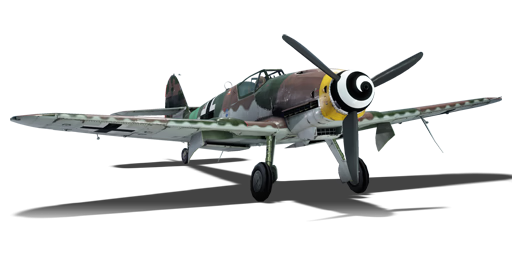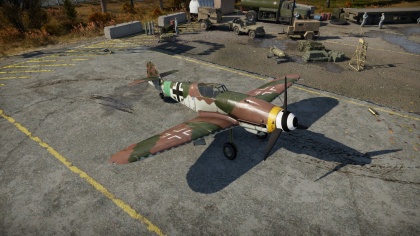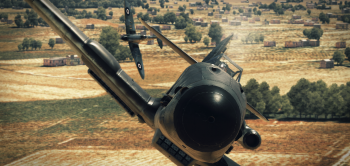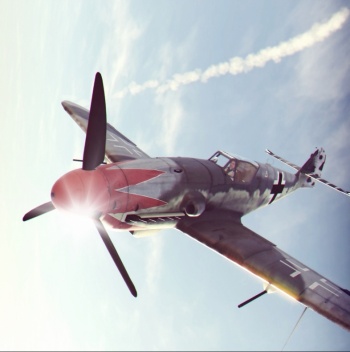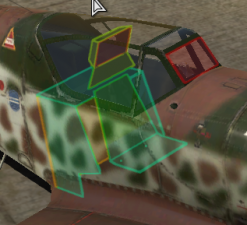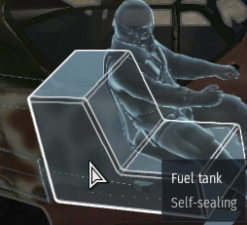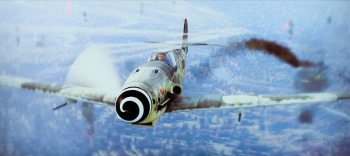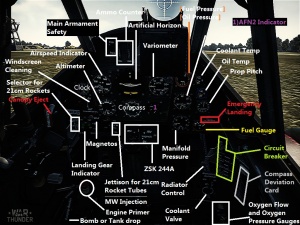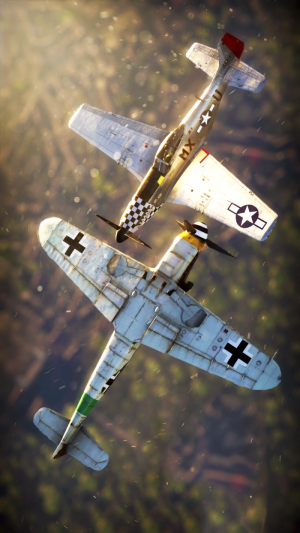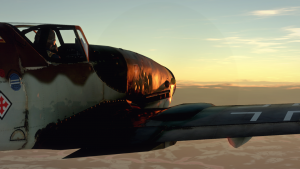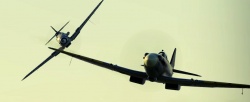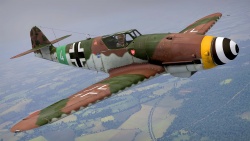Difference between revisions of "Bf 109 K-4"
(Edits and images.) |
Inceptor57 (talk | contribs) (Readded xray image of fuel, readded description of armor to main text body) |
||
| Line 69: | Line 69: | ||
|- | |- | ||
|} | |} | ||
| − | |||
{| class="wikitable" style="text-align:center" | {| class="wikitable" style="text-align:center" | ||
|- | |- | ||
| Line 94: | Line 93: | ||
=== Survivability and armour === | === Survivability and armour === | ||
<!-- ''Examine the survivability of the aircraft. Note how vulnerable the structure is and how secure the pilot is, whether the fuel tanks are armoured, etc. Describe the armour, if there is any, and also mention the vulnerability of other critical aircraft systems.'' --> | <!-- ''Examine the survivability of the aircraft. Note how vulnerable the structure is and how secure the pilot is, whether the fuel tanks are armoured, etc. Describe the armour, if there is any, and also mention the vulnerability of other critical aircraft systems.'' --> | ||
| − | The 109 K-4 has a very substantial amount of armour around the pilot but is mainly to protect the gigantic fuel tank your pilot is sitting on top off. The fuel tank, however, is self-sealing. | + | <gallery mode="packed-hover" heights="150px"> |
| + | File:BF 109 K-4 All armor.png|All the armour plates on the 109 K-4 | ||
| + | File:Fuel tank 109 K4.png|Picture of the giant fuel tank the pilot is sitting on (self-sealing) | ||
| + | </gallery> | ||
| + | The 109 K-4 has a very substantial amount of armour around the pilot, but is mainly to protect the gigantic fuel tank your pilot is sitting on top off. The fuel tank, however, is self-sealing. | ||
| + | |||
| + | * 60 mm bullet proof glass in front and rear of pilot | ||
| + | * Fuel tank with 21 mm steel plate behind it, and 4 mm plates surrounding it | ||
| + | * Pilot's seat has 4 mm steel plates underneath, with 8 mm steel making up the back rest | ||
| + | * 10 mm steel plates surrounding rear bullet proof glass | ||
== Armaments == | == Armaments == | ||
Revision as of 17:13, 10 December 2019
Contents
| This page is about the German fighter Bf 109 K-4. For other uses, see Bf 109 (Family). |
Description
The Bf 109 K-4 is a rank IV German fighter
with a battle rating of 6.3 (AB) and 5.7 (RB/SB). It has been in the game since the start of the Open Beta Test prior to Update 1.27. The K-4 is the pinnacle of the famed 109 series. The 'Kurfürst' frame is the last iteration and was focused on ease of production rather than performance, yet it features the best power to weight ratio and acceleration of any 109, turning this machine into a beast. However, the age of the design is reflected in its poor high-speed characteristics.
Use the plane's outstanding climb rate and speed retention. Energy fighting tactics should be this plane's primary mode of fighting. It has good acceleration when using WEP. This grants the machine reasonable zoom climbing abilities. If chased, dodge away from the enemy with fancy manoeuvres without losing too much speed. In Realistic Battles, try to do a climbing spiral, but be sure to be in a higher energy state than the enemy! A miscalculation and the foe will have the opportunity for an easy deflection shot.
However, there are also downsides. The top speed can be reached quickly, yet the plane is not fast when stock. While it does have an edge in agility, it has bad low-speed manoeuvrability. Furthermore, foes will not usually engage in manoeuvring combat, rendering any manoeuvrability advantage moot.
K-4 can outmanoeuvre these planes at medium speeds (<450 km/h IAS): P-51 (all types), P-47D, Typhoons and the La-9. However, it will have a hard time dealing with other late Rank IV aircraft, especially Spitfires. It is highly recommended to use rudder during rolls as this increases the roll rate dramatically. This is useful if when trying to force an overshoot or when avoiding shots.
General info
Flight performance
Describe how the aircraft behaves in the air. Speed, manoeuvrability, acceleration and allowable loads - these are the most important characteristics of the vehicle.
| Characteristics | Max Speed (km/h at 6,000 m) |
Max altitude (meters) |
Turn time (seconds) |
Rate of climb (meters/second) |
Take-off run (meters) | |||
|---|---|---|---|---|---|---|---|---|
| AB | RB | AB | RB | AB | RB | |||
| Stock | 685 | 665 | 12800 | 20.3 | 21.1 | 18 | 333 | |
| Upgraded | 759 | 720 | 18.3 | 19.0 | 32.2 | 23.8 | ||
Details
| Features | |||||
|---|---|---|---|---|---|
| Combat flaps | Take-off flaps | Landing flaps | Air brakes | Arrestor gear | Drogue chute |
| ✓ | ✓ | ✓ | X | X | X |
| Limits | ||||||
|---|---|---|---|---|---|---|
| Wings (km/h) | Gear (km/h) | Flaps (km/h) | Max Static G | |||
| Combat | Take-off | Landing | + | - | ||
| 460 | ___ | 260 | ~13 | ~6 | ||
| Optimal velocities (km/h) | |||
|---|---|---|---|
| Ailerons | Rudder | Elevators | Radiator |
| < 450 | < 390 | < 450 | > 715 |
| Compressor | Optimal altitude | 100% Engine power | WEP Engine power |
|---|---|---|---|
| Setting 1 | 6,900 m | 1,250 hp | 1,775 hp |
Survivability and armour
The 109 K-4 has a very substantial amount of armour around the pilot, but is mainly to protect the gigantic fuel tank your pilot is sitting on top off. The fuel tank, however, is self-sealing.
- 60 mm bullet proof glass in front and rear of pilot
- Fuel tank with 21 mm steel plate behind it, and 4 mm plates surrounding it
- Pilot's seat has 4 mm steel plates underneath, with 8 mm steel making up the back rest
- 10 mm steel plates surrounding rear bullet proof glass
Armaments
Offensive armament
The Bf 109 K-4 is armed with:
- A choice between two presets:
- 1 x 30 mm MK 108 cannon, nose-mounted (65 rpg) + 2 x 13 mm MG 131 machine guns, nose-mounted (300 rpg = 600 total)
- 1 x 20 mm MG 151 cannon, nose-mounted (200 rpg) + 2 x 13 mm MG 131 machine guns, nose-mounted (300 rpg = 600 total)
Suspended armament
The Bf 109 K-4 can be outfitted with the following ordnance:
- Without load
- 2 x 20 mm MG 151 cannons, wing-mounted (135 rpg = 270 total)
Usage in battles
The MK 108 is a double-edged sword: Nicknamed by the allies for its characteristic sound, the `Jackhammer´ lives true to its name. Slow but powerful. Its main purpose: Demolition of heavy objects, such as the B-17G Flying Fortress. However, its common purpose in War Thunder remains to hunt fighter planes. The cannon's rate of fire is extremely low, making it good for conserving ammo, but bad for deflection shots. Furthermore, the minengeschoß-shells are slow- very slow. One must either become very good at leading the shells or close the distance. Kills are generally done from 300 meters away, if not closer. On the plus side, the damage is equivalent to most 37 mm cannons upon hitting. Tip: In order to better learn and understand the cannon's trajectory, do not fire in conjunction with the machine guns.
The two additional machine guns are best fired alone. The MG 131 features HE shells (named IAI in-game) as the Tracer belt. Yet they are only highly effective in Simulator battles, where they will deal good damage to control surface areas, causing inexperienced pilots to lose control. In Arcade and Realistic battles, however, the instructor will dampen any such effects. Here, the damage-based Stealth and Fighter belts fare better.
The plane should equip one of two load-outs: with either the single 30 mm cannon or 2 x 20 mm cannons. The single 30 mm is very capable of taking out 2-3 bombers and the low muzzle velocity matters less due to the large targets. The 3 x 20 mm cannons are very capable of taking out fighters due to the high shell density and sheer damage output. A single 20 mm does not deal enough damage and the 30 mm with gun pods is rather ineffective due to the differing muzzle velocities of the 30 mm and 20 mm cannons.
One technique you can use is the prop pitch technique. Most of the later 109s have this but it is really effective in the 109 K-4. The prop pitch technique is using Manual Engine Control (found in sim controls) to set your prop pitch to 100% but throttle to 0%. This will make your prop, a giant air brake and is very helpful in forcing overshoots of the enemy aircraft. It can also be very helpful in diving where you might get dangerously close to your rip speed.
Manual Engine Control
| MEC elements | ||||||
|---|---|---|---|---|---|---|
| Mixer | Pitch | Radiator | Supercharger | Turbocharger | ||
| Oil | Water | Type | ||||
| Not controllable | Controllable Auto control available |
Controllable Auto control available |
Controllable Auto control available |
Separate | Not controllable 1 gear |
Not controllable |
Modules
| Tier | Flight performance | Survivability | Weaponry | ||
|---|---|---|---|---|---|
| I | Fuselage repair | Radiator | Offensive 13 mm | MG.151/20 cannon | |
| II | Compressor | Airframe | New 13 mm MGs | R4 modification | |
| III | Wings repair | Engine | Offensive 30 mm | Offensive 20 mm | |
| IV | Engine injection | Cover | New 30 mm cannons | New 20 mm cannons | |
The true acceleration power of the plane is only achieved very late into the grind. Specifically, the Tier 4 Engine injection modification provides a significant boost and is a top priority. On the way there, all engine upgrades should be taken. 13 mm belts are helpful for removing tracer rounds. The 20 mm gun pods with belts and the gun upgrade are viable choices but engine injection remains a priority.
Pros and cons
Pros:
- Very powerful engine when using WEP, providing excellent acceleration and climb rate
- Manual engine control can extend the climb rate and top speed in realistic and simulator battles
- Nose mounted weaponry
- Good performance at medium altitude
- Good firepower for destroying larger attackers and bombers
- Can carry additional armament
- Performance on par with Griffon Spitfires (even better when fully upgraded)
- 30 mm cannon will usually destroy anything that it hits
- Can research nose-mounted 20 mm MG 151 cannon, which makes deflection shooting much more reliable
- Exceptional high-speed manoeuvrability
Cons:
- Low cannon ammunition count for the 30 mm MK 108 cannon and the 13 mm MG 131 machine guns
- Low velocity 30 mm shell with a high drop, resulting in a VERY large lead angle on targets in turn leading to poor dogfight performance due to having to pull extreme turns to get guns on target
- Flimsy airframe, prone to react heavily to damage
- When aircraft is stock, very heavy and slow to fly without WEP
- Stock 13 mm machine gun belts consist solely out of tracers which alerts enemy, makes aiming 30 mm difficult
- Fighters with lower top speeds but better low altitude performances (such as Russia's La-7 fighters) will find it quite easy to run down the K-4 when at a low energy state
- Very slow deploying flaps
History
The Bf 109 K-4 was one of Kurfurst Bf 109 series, Kurfurst was the last series of 109 before war's end. The K series was the most upgraded and most expensive 109 and with the war coming to an end not many were built. Work on the K series began in the spring of 1943 and prototype was ready by autumn of the same year. The series began production in August 1944 with the K-4 but due to changes to the design and delays with the new DB605D engine, the K-4 was the only one to be mass-produced. Externally, the Kurfurst series had changes in radio equipment location hatch. A filler point for the fuselage fuel tank, and with removal of the D/F loop, were the main external differences to other Bf109 series. The landing gear also had doors that closed up the bottom completely and armament was the Motorkanone 108 (30 mm) , 2 x MG 131 (13 mm), with additional 2 gun pods of MG 151 (20 mm). Payloads included a 500 kg bomb or on rare occasion Wfr.Gr.21 Rockets (21 cm). Due to limited resources, many of the variants didn't enter production.
Variants:
- R I ETC 501/IX b or Schloß 503belly bomb rack, fusing equipment for fitting a 250 kg (550 lb) or 500 kg (1,100 lb) bomb
- R III Schloß 503A-1 rack for one fuselage drop tank (300 L/80 US gal).
- R IV BSK 16 gun-camera in the left-wing between nose ribs 3 and 4.
- R VI two 20 mm Mauser MG 151/20 underwing gun pods with 135 RPG.
- K-0 Pre-production aircraft, powered by a DB 605DM engine
- K-2 proposed version without a pressurized cockpit
- K-4 only serial production version without pressurized cockpit, powered by a DB 605DM (early on) or DB/DC engine
- K-6 proposed heavy fighter version, as K-4 with reinforced wings holding two additional 30 mm MK 108 cannons and additional armour
- K-8 proposed reconnaissance version, equipment similar to G-8
- K-10 proposed version, similar to K-6, MK 103 M engine cannon instead of MK 108
- K-12 proposed version, dual-seat trainer similar to G-12
- K-14 proposed version, similar to K-6, powered by a DB 605L engine
In-game description
The Messerschmitt Bf 109 was a single-seat monoplane fighter used by the Luftwaffe before and during WWII. It was used as a fighter, interceptor, high-altitude interceptor, fighter-bomber and reconnaissance aircraft.
The Bf 109K "Kurfuerst" was the last mass-produced variant of the Bf 109 family. It first reached front-line units in September 1944 (or early 1945, according to other data). The fighter was powered by the Daimler-Benz DB 605 DCM engine and had more powerful armament, with some variants equipped with two 15mm or three 30mm cannon.
Media
- Images
- Videos
See also
- Aircraft of comparable role, configuration and era
- Mitsubishi A6M
- Bell P-39 Airacobra
- Curtiss P-36
- Curtiss P-40
- Dewoitine D.520
- Fiat G.55
- Focke-Wulf Fw 190
- Grumman F4F Wildcat
- Grumman F6F Hellcat
- Hawker Hurricane
- Heinkel He 112
- IAR-81
- Kawasaki Ki-61
- Lavochkin LaGG-3
- Macchi C.202
- Macchi C.205
- Mikoyan-Gurevich MiG-3
- Morane-Saulnier MS.406
- Nakajima Ki-43
- North American P-51 Mustang
- Polikarpov I-16
- Supermarine Spitfire
- Yakovlev Yak-1
- Yakovlev Yak-9
External links
- [Chuckhawks.com website ] The Best Fighter of its Generation (1935-1945): Messerschmitt Bf 109
- [Luftkrieg-ueber-europa.de website ] How good was the Messerschmitt Bf 109?
- [Kurfurst.org website ] Kürfurst - The Messerschmitt Bf 109 Performance Resource Site
| Germany fighters | |
|---|---|
| Heinkel | |
| He 51 | He 51 A-1 · He 51 B-1 · He 51 B-2/H · He 51 C-1 · He 51 C-1/L |
| He 100 | He 100 D-1 |
| He 112 | He 112 A-0 · He 112 B-0 · He 112 B-1/U2 · He 112 B-2/U2 · He 112 V-5 |
| Messerschmitt | |
| Bf 109 (Jumo) | Flegel's Bf 109 A · Bf 109 B-1 · Bf 109 C-1 |
| Bf 109 (DB-601) | Bf 109 E-1 · Bf 109 E-3 · Bf 109 E-4 · Bf 109 E-7/U2 · Bf 109 F-1 · Bf 109 F-2 · Bf 109 F-4 · Bf 109 F-4/trop |
| Bf 109 (DB-605) | Bf 109 G-2/trop · Bf 109 G-2 · Bf 109 G-6 · Bf 109 G-10 · Bf 109 G-14 · Bf 109 K-4 |
| Focke-Wulf | |
| Fw 190 (early) | Fw 190 A-1 · Fw 190 A-4 · Fw 190 A-5 · Fw 190 A-5 · Fw 190 A-5/U2 · Fw 190 A-5/U14 · Fw 190 A-8 · Fw 190 C |
| Fw 190 (late) | Fw 190 D-9 · Fw 190 D-12 · Fw 190 D-13 |
| Ta 152 | Ta 152 C-3 · Ta 152 H-1 |
| Blohm & Voss | |
| BV 155 | BV 155 B-1 |
| Foreign: | |
| USA | ▀P-47D-16-RE · ▀P-47D |
| USSR | ▀La-5FN · ▀Yak-1B |
| Britain | ▀Tempest Mk V |
| Italy | ▀CR.42 · ▀Marcolin's C.R.42 CN · ▀G.50 serie 2 · ▀G.50 AS serie 7 · ▀C. 200 serie 3 · ▀C. 200 serie 7 · ▀C. 202 |
| Finland | ▀Hawk H-75A-2 |


